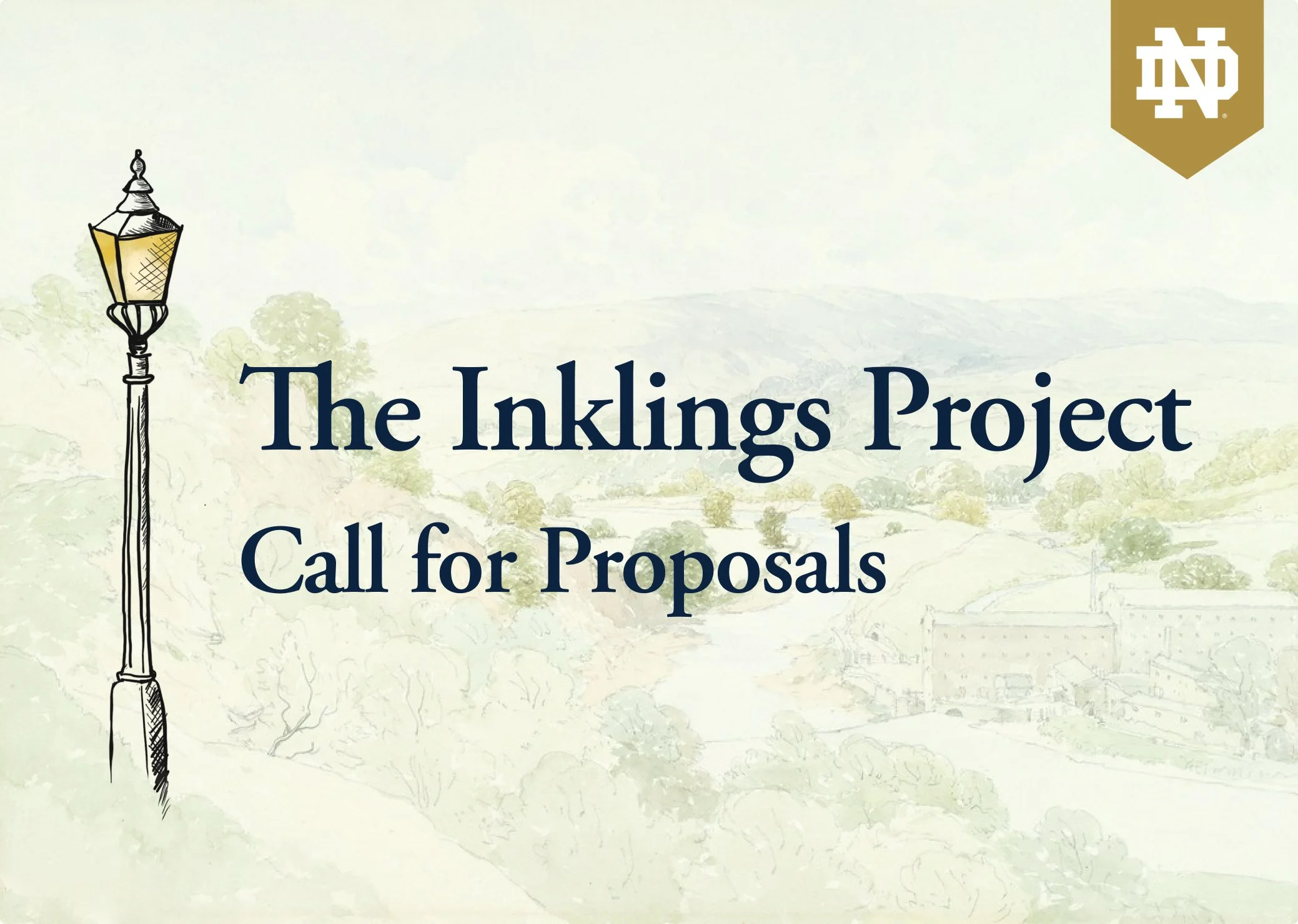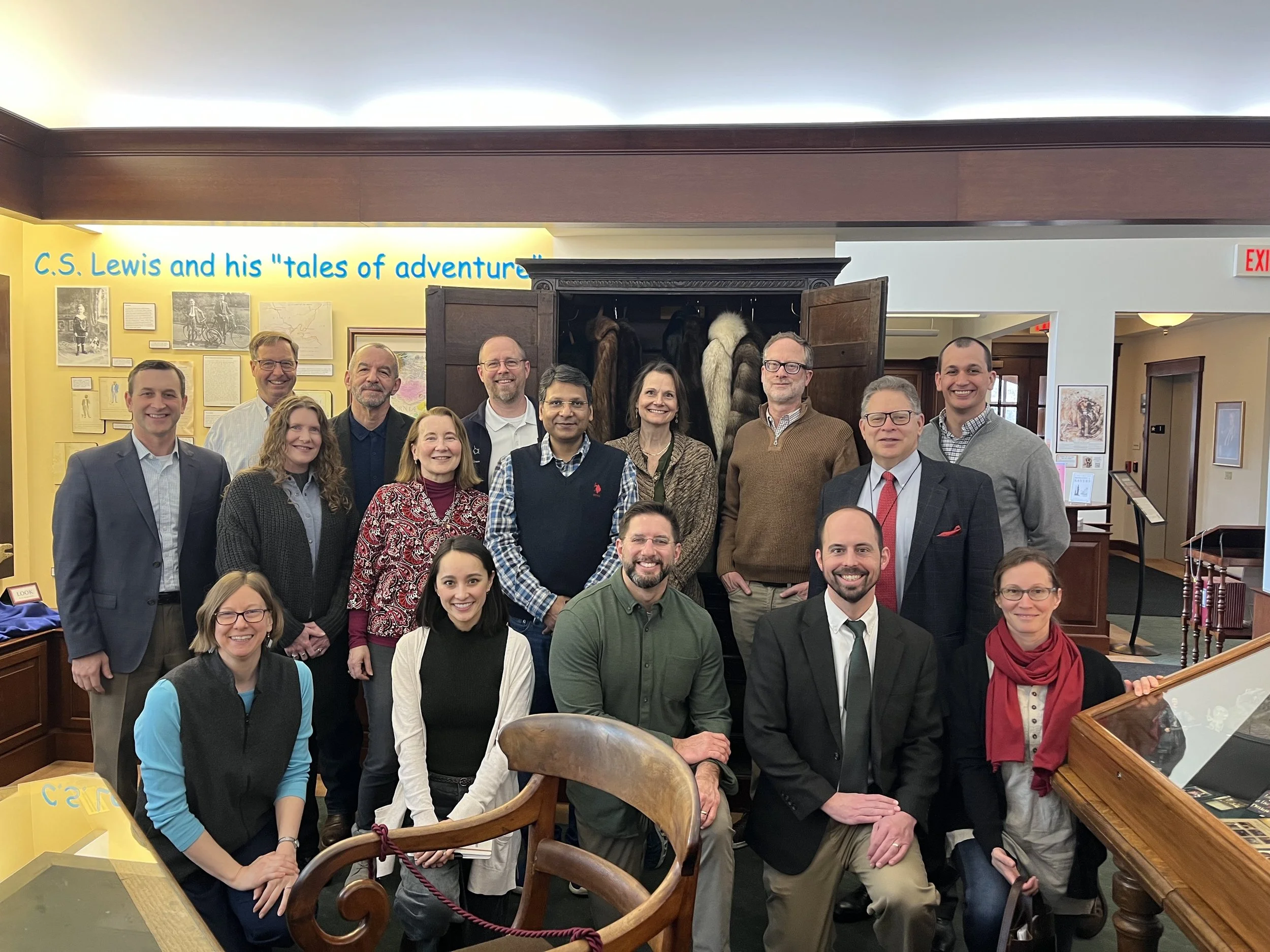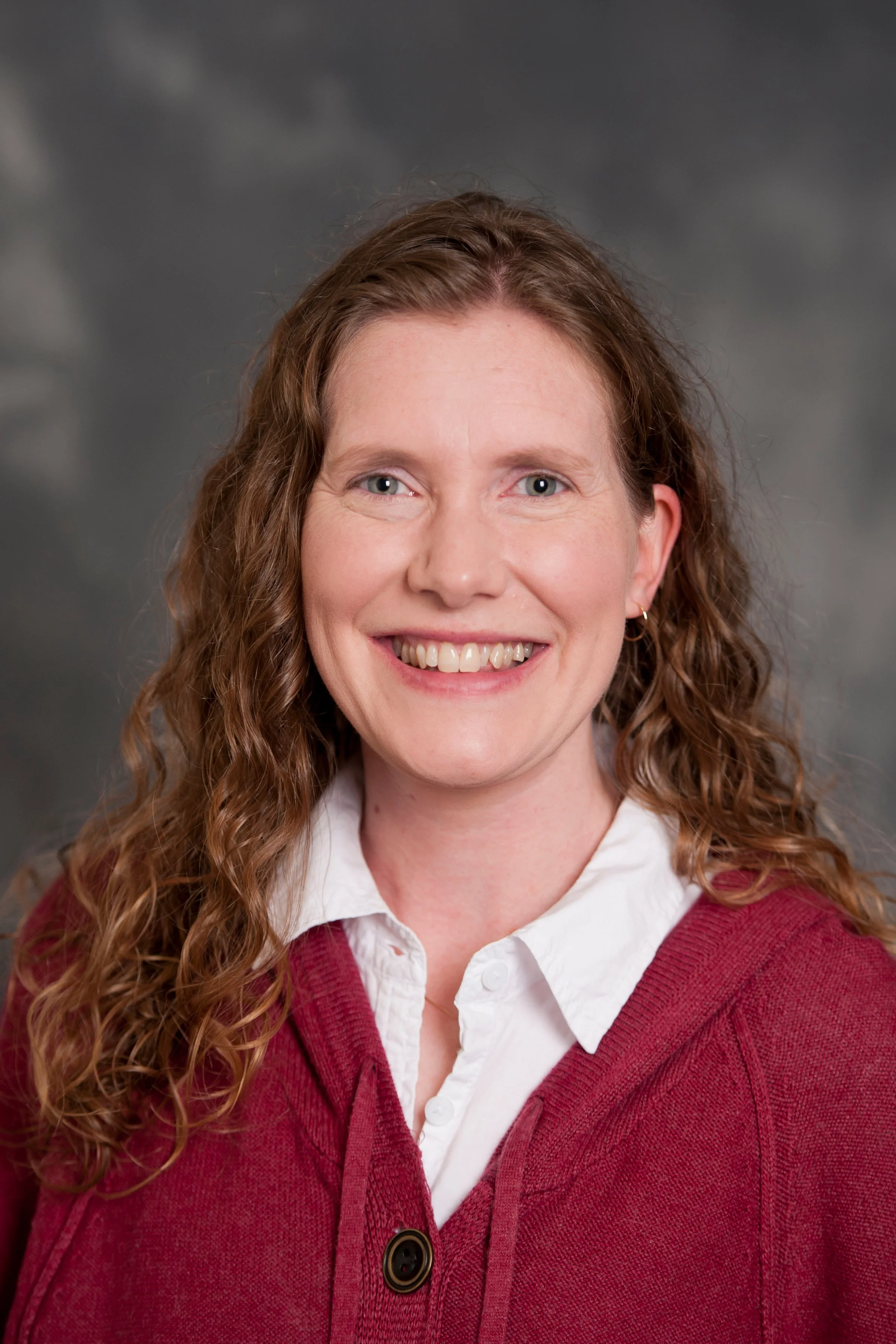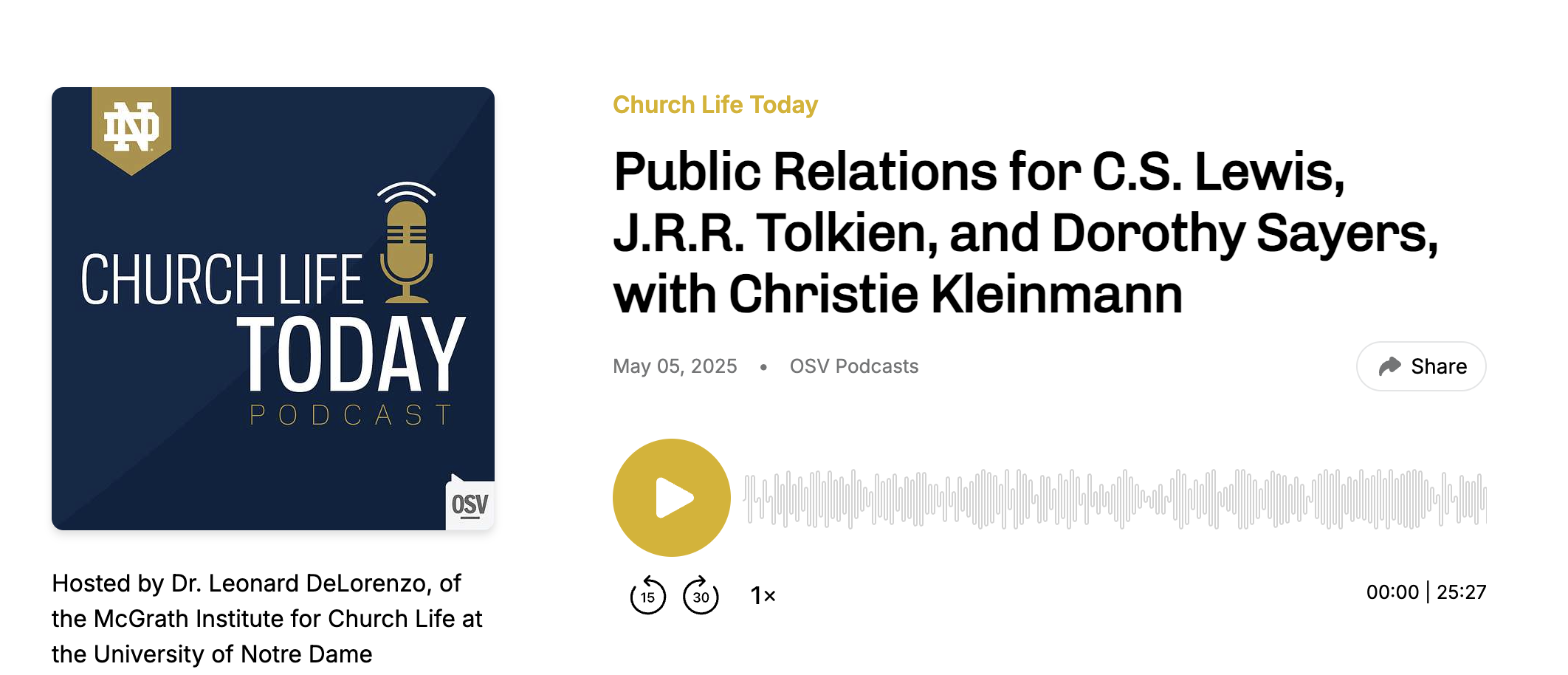IQ 7: Call for Proposals, Public Relations for the Inklings at Belmont University, Tolkien & Lewis at Harvey Mudd College
Inklings Quarterly
May 13, 2025
Call for Proposals
AY 2025-26 Inklings Project Application Now Open
The Inklings Project requests fellowship applications from faculty at universities and colleges to encourage the teaching of the works of the Inklings, especially but not limited to C. S. Lewis and J. R. R. Tolkien. Among other benefits, grants in the amount of $1,500 are awarded to fellows for creating and teaching Inklings-related courses.
The Inklings Project welcomes a variety of courses that delve into the works of the Inklings and engage students (e.g., a freshman writing seminar, a course engaging STEM students, in-person or online/hybrid venues). These courses may focus on fiction and/or nonfiction and may also include the writings of related authors (e.g., G. K. Chesterton, Dorothy Sayers, George MacDonald). Faculty from all disciplines, including STEM, are encouraged to apply. We especially welcome applications from faculty with no prior experience teaching the Inklings, as well as experienced faculty who endeavor to expand their course to a new audience (e.g., through a new setting or pedagogical format).
Fellowship applications are due July 1, 2025. For more information, please view the full Call for Proposals (link here), or visit www.inklingsproject.org/apply.
The Joy of the Fellows Gathering
Liz Zenger, Program Manager of the Inklings Project
This year’s Inklings Project Fellows Gathering took place on March 7 and 8, 2025. The Fellows Gathering is a time when the year’s cohort of fellows meets together—in-person, which is no small feat—for rich discussions around content, pedagogy, and outreach as they relate to the Inklings. There are a few very special things about this gathering that make it an invaluable part of the Inklings Project Fellowship.
The first is that the location embodies the content, so that the space reflects and inspires the topics discussed. The gathering takes place at the Wade Center of Wheaton College, a treasure trove of Inklings manuscripts, letters, books, secondary sources, and rare artifacts. It is fitting, then, that the first day of the two-day gathering is set aside for fellow research in the Kilby Reading Room. In addition, early on the second day, the staff at the Wade Center gives the fellows a tour of the museum, which includes J. R. R. Tolkien’s desk, C. S. Lewis’ desk, and the wardrobe that C. S. Lewis’ grandfather carved and that Lewis and Warnie used to play in as children. The fellows are also able to view some of the Reading Room’s most invaluable treasures, including hand-written manuscripts and letters of C. S. Lewis and J. R. R. Tolkien, rare first editions, drawings by G. K. Chesterton, and books signed by George MacDonald.
The second is the active spirit of the gathering—every fellow contributes to each of the three sessions. In the spirit of the original Inklings meetings, fellows talk in the comfortable environment provided by the Harbor House, located across the street from the Wade Center. Gathered in small groups in the living room or sunroom, with lots of coffee and food to contribute to the “hobbit-like” atmosphere, the fellows discuss the Inklings’ work and how to best teach them. Thus emerges an exchange of questions, ideas, stories, and lessons learned. For isn’t this the true spirit of fellowship? Giving and receiving, while looking together at a shared love.
The third is the energy the fellows leave with at the end of the gathering. Heralding from all over the world—this past year we had fellows attend from India, France, and California to name a few places—the fellows are able to encourage one another in the specific work they are doing at their university or college. The spirit of fellowship and inspiration that results is palpable by the time we say goodbye. Our hope is that each fellow leaves feeling a sense of camaraderie in teaching the Inklings, and more equipped and energized to share their love for the Inklings.
We aim to provide the fellows with a myriad of resources throughout the Inklings Project Fellowship: a grant, resources, opportunities, special access to the Reading Room, etc. However, both we and our fellows know that the most important aspect of the program is the fellowship—their relationships with one another. The people in their cohort, the talented and dedicated individuals they are connected with throughout the year and spend a weekend with at the Wade Center, are their most valuable resource. For at the heart of the Inklings, and the Inklings Project, is fellowship.
Wonder to Wisdom: The “Inklings PRoject” at Belmont University
Dr. Christie Kleinmann | AY24-25 Inklings Project Fellow
Professor of Public Relations, Belmont University (Nashville, Tennessee)
This spring, Belmont University’s “Inklings PRoject” course brought together the imaginative worlds of J. R. R. Tolkien, C. S. Lewis, and Dorothy Sayers with the practical skills of strategic public relations. Under the guidance of Dr. Christie Kleinmann, students became “brand ambassadors” for these authors, developing campaigns to introduce their works to a new generation of college students.
Students were divided into three groups, each tasked with representing one of the Inklings. Their challenge: capture the wonder of these authors’ worlds and lead their fellow students toward the wisdom at the heart of their stories. The result was a vibrant mix of strategy, creativity, and hands-on learning.
Bringing Sub-Creation to Life with Tolkien
The Tolkien team centered their campaign on the theme of “sub-creation”— Tolkien’s idea that humans, made in the image of the Creator, are themselves creators of worlds, stories, and meaning. The group partnered with the architecture department to bring this concept to life, inviting students to explore how sub-creation is relevant to today’s creative disciplines. They hosted a campus event that facilitated discussion on the intersection of literature and design and created visually rich social media content to broaden their reach.
“I never would have learned about sub-creation on my own, and certainly not to this extent,” said Lily Rosen. “It’s been an honor to learn about Tolkien’s philosophy and creative process while also enjoying his works and sharing them with others.”
The hands-on nature of the campaign made the experience especially meaningful. Jed Mangrum, a member of the Tolkien group, explained, “We planned events, made content, and promoted our author’s brand. Learning public relations by actually doing it gave me skills I didn’t have before, and a new appreciation for Tolkien.”
Bringing Wisdom to Life with Lewis
The Lewis group produced engaging social media reels, recorded podcasts, and wrote news releases that connected Lewis’ ideas to student life. A highlight of their campaign was partnering with songwriter Matt Wheeler, who met with students to discuss how classical literature, including the works of the Inklings, inspired his music and creative process. This collaboration offered students a firsthand look at how Lewis’ influence extends beyond books and into contemporary art and songwriting.
“My biggest takeaway is the reminder that the wonder and wisdom of Lewis’ works can and should live together,” said Ryleigh Green. “Our best work came from remembering why we love these authors and sharing this love with others.”
Bringing Mystery to Life with Sayers
The Sayers group faced the challenge of introducing an author less familiar to their peers. To engage students, they planned and executed a campus scavenger hunt that immersed participants in one of Sayers’ mysteries, inviting them to solve a murder by piecing together clues from her story. The event was well attended and introduced many students to Sayers’ sharp wit and intricate plots in a memorable, interactive way.
Alongside the scavenger hunt, the group used paid social ads, pitched stories to campus media, and created audience personas to connect Sayers’ intellect and literary achievements with modern students.
“At first, I didn’t know much about Sayers,” said Mackenzie Cosgriff. “But the more I read, the more I appreciated the depth of her work. Sayers didn’t just write for entertainment; she wrote to make people think.”
Bringing Discovery to Life: Student Reflections
The Inklings PRoject’s impact went beyond metrics and media. Students were challenged not only to master new skills in writing, communication, and campaign strategy, but also to collaborate, connect with campus partners, and bring classic literature to life in creative ways. “Using the Inklings as a medium to learn public relations was amazing. I love literature and reading, and discussing the wisdom of these great writers was an invaluable experience,” said Lily Rosen.
Many students found themselves stepping outside their comfort zones and discovering new passions. Adriana Alonso, who worked on the Sayers campaign, never expected to become so invested in these classic authors. “I’d never have believed you if you told me a year ago I’d find a love for J. R. R. Tolkien or become so passionate about introducing Dorothy Sayers to others,” said Alonso. “Being able to explore Tolkien, Sayers, and Lewis has re-sparked my interest in the classics and inspired me to delve deeper into what these authors have to offer.”
For others, the project was an opportunity to overcome intimidation and engage more deeply with challenging material. Lucy Benish reflected on her journey. “This semester I read works from C. S. Lewis, J. R. R. Tolkien, and Dorothy Sayers-three writers I had always been curious about, but felt too intimidated to read,” said Benish. “Not only did I read these works, but I surprised myself with my ability to participate in thoughtful discussions on their writing and relate it to my own life.”
Senior Eva Campos summed up the project’s lasting value. “The Inklings Project course added value to my final semester at Belmont in ways I did not expect. I had no idea how much wisdom I would come across and lessons I would learn through studying this rich work of the Inklings.”
By merging the timeless wonder of Tolkien, Lewis, and Sayers with modern communication strategy, students not only bridged generations but discovered that the wisdom of the Inklings still speaks to the questions and dreams of today’s students.
Interested in learning more about the Inklings and public relations?
Dr. Kleinmann joined Dr. Lenny DeLorenzo on the Church Life Today podcast to talk about the project of her course, the relevance of the Inklings, and the creativity of her students. You can listen to the podcast here!
From a Fellow
Dr. David Vosburg | AY24-25 Inklings Project Fellow
Professor of Chemistry, Harvey Mudd College (Claremont, California)
Interview with Dr. David Vosburg | Teaching Tolkien and Lewis at Harvey Mudd College
One of this year’s Inklings Project Fellows is Dr. David A. Vosburg, the Donald A. Strauss Professor of Chemistry at Harvey Mudd College in Claremont, California. He has developed a reputation on campus for occasionally wearing a wizard robe and having Tolkien-related art and Legos in his office. Below, we ask him a few questions about his Inklings experience.
1. When did you start enjoying the works of the Inklings?
Reading Lewis’ Narnia series as a child was formative for me, as was watching the animated The Hobbit movie. But I’d say the most impactful has been Tolkien’s The Lord of the Rings. At college I met several huge Tolkien fans, including Tolkien scholars Wayne Hammond and Christina Scull, as well as fellow student Corey Olsen who later gained international renown as The Tolkien Professor.
2. Can you tell us about your Inklings-related course?
My course is a seven-week, co-taught freshman writing seminar course with 16 students. Across eight offerings of the course, I’ve teamed up with co-instructors from religious studies, math, computer science, and engineering. This year, our students read Tolkien's creation story “Ainulindalë” from The Silmarillion, Lewis' chapter “A Further Difficulty in Naturalism” from his book Miracles, N. K. Jemisin's futuristic short story “The Ones Who Stay and Fight,” and Martin Luther King, Jr's famous “I Have a Dream” speech. Our theme was “Right and Wrong, Good and Evil?” I don't know when I'll teach this course next, but my plan for that time—if I can convince a co-instructor to go along with it—would be to go all-in on Tolkien and use “Ainulindalë” (that is the only source I have used all eight times I have taught the course), the short story “Leaf by Niggle,” the poem “Mythopoeia,” and the chapter “Of Aulë and Yavanna” from The Silmarillion. These four sources span diverse genres, yet center on ideas of creation and creativity.
3. What is your student population like? How do they receive Lewis and Tolkien's works?
Our student population at Harvey Mudd is a lot like the undergraduate students at MIT or Caltech: nerdy, very into math and science, and highly motivated. One difference is that we’re a liberal arts college, which is very rare for a STEM-focused school. Most of our domestic students are aware of Tolkien or The Lord of the Rings (LOTR), and we have sometimes had LOTRathons in which students and faculty take turns reading chapters from LOTR over the course of a weekend. Our students’ affinity for Tolkien mirrors their enjoyment of the role-playing game Dungeons & Dragons, which was inspired by Middle-earth. As a secular campus, our students are much less likely to be familiar with Lewis, though some know of the Narnia series. But some of our Christian students and spiritually curious ones find great delight and inspiration in Lewis’ works, such as Mere Christianity, The Screwtape Letters, and The Great Divorce. Some of my students have found their way to faith through Lewis, much as former NIH director Francis Collins did.
4. Do you have a favorite part about teaching your course? Any highlights to share with us?
One favorite part is dressing up as “Shandalf the Beige”—named after our Shanahan building and the color of my robe—for a dramatic reading of the opening chapter of Tolkien’s The Silmarillion on the first day of class, which I have now done eight times. Another cherished aspect is weekly one-on-one meetings with students to discuss their thoughts about Tolkien’s big ideas in the stories we read. For instance, what do they make of the relationship between the creator of the world and an angelic being who selfishly seeks power and introduces chaos and strife into the world? Or what do they think of the spiritual journey depicted in Tolkien’s “Leaf by Niggle”?
5. Is there anything you would like to share about your time as an Inklings Project Fellow?
Our gathering at Wheaton College in March was fabulous! Highlights included rooming with a Fellow from India, participating in vibrant conversations on Inklings topics with a wide variety of Fellows and staff, reading even a tiny fraction of the holdings at the Kilby Reading Room, and seeing unique Inklings artifacts at the Wade Center.
6. What Inklings works are you most excited about right now? Why?
I’ll pick three, along a Tolkien-to-Lewis trajectory.
The first is a quote from Tolkien’s The Silmarillion that my students know is an inspiration for me as a molecule maker. One of my former students painstakingly made two hand-press prints of this quote for me, which I now have framed in both my home and work offices. It reads: “Yet the making of things is in my heart from my own making by thee; and the child of little understanding that makes a play of the deeds of his father may do so without thought of mockery, but because he is the son of his father.” I make things because God made me, because it satisfies my inner desires, and because my creative acts honor my Creator.
The second is a Tolkien poem that I recently rediscovered when reading a graphic novel by John Hendrix: The Mythmakers: The Remarkable Fellowship of C.S. Lewis & J.R.R. Tolkien. The poem is “Mythopoeia,” which Tolkien wrote in the early 1930s soon after a pivotal evening conversation with Lewis that catalyzed Lewis’ conversion to Christianity. In it, Tolkien argues for the truth of myth (not here meant with any of the negative associations we might have with the word ‘myth’) and that Christianity is true myth. Upon re-reading “Mythopoeia,” I realized that it holds great interpretive power regarding the value of creation and creativity in Tolkien’s autobiographical short story, “Leaf by Niggle,” which I’d already used four times in my writing course. So now I want to use “Mythopoeia” and “Leaf by Niggle” together!
The third is Lewis’ Narnia series, which is where I began my Inklings exposure. My appreciation for these books has been invigorated and completely reshaped by two remarkably insightful books by Lewis scholars. The first of these is Planet Narnia: The Seven Heavens in the Imagination of C. S. Lewis by Michael Ward, also available as a shorter and more accessible adaptation in The Narnia Code: C. S. Lewis and the Secret of the Seven Heavens. Ward’s work opened my eyes to the—stunningly previously undiscovered—coherent structure and character of the Narnia series by mapping each of the seven books onto one of the seven primary heavenly bodies of medieval cosmology (Jupiter, Mars, the sun, the moon, Mercury, Venus and Saturn). The second is The Chronicles of Transformation: A Spiritual Journey with C. S. Lewis, edited by Inklings Project director Leonard J. DeLorenzo. Lenny gave each of the Fellows a copy of his book during our meeting at the Wade Center, which I proceeded to read over the month that followed. As Catholic philosopher Peter Kreeft attested on the book’s back cover, I was very surprised and impressed with the depth of new spiritual insights each of the authors—and Lenny’s son Isaac—offered on dimensions of spiritual transformation in the Narnia books. As before with Planet Narnia, I was inspired to see with greater clarity God’s great work through an Inklings author.
Fellow Spotlights
Dr. Dominic A. Aquila | AY24-25 Inklings Project Fellow
Professor of History, The University of St. Thomas (Houston, Texas)
Bringing The Most Reluctant Convert to Campus
This past semester, Dr. Dominic Aquila organized a showing of The Most Reluctant Convert, a movie about C. S. Lewis’ spiritual journey from atheism to “reluctant convert.” The event was sponsored by the History Society of the University of St. Thomas and was organized in collaboration with the Fellowship for Performing Arts (FPA).
Following the showing, Dr. Aquila facilitated a 30-minute discussion of the film. The audience members—which consisted of about 200 students, faculty, and quite a few members of the wider Houston community—engaged in the discussion with passion and insight. Curiously, much of the interest centered on the pivotal 1931 conversation around Addison’s Walk between C.S. Lewis and J.R.R. Tolkien, which led to Lewis's final step toward Christianity.
To learn more about the Fellowship for Performing Arts and their campus initiatives, visit https://fpatheatre.com/campus-initiative/.
Dr. Yuliia Vintoniv | AY24-25 Inklings Project Fellow
Lecturer at the Department of Pastoral Theology, Ukrainian Catholic University
International Seminar: “Elaborating a Theology of Grief: Ecumenical Commitment” in Lviv
This past March, Dr. Yuliia Vintoniv contributed to an international seminar and discussion entitled “Elaborating a Theology of Grief: Ecumenical Commitment.” The event took place at the Ukrainian Catholic University in Lviv, where Yuliia teaches, and brought together leaders and academics from a variety of Christian churches. Yuliia’s paper was entitled “A mourning of God himself: the Silent Godforsaken Prayer.”
You can read more about the event on the Institute of Ecumenical Studies’ website: https://ies.ucu.edu.ua/en/news/eng-international-seminar-elaborating-a-theology-of-grief-ecumenical-commitment-held-in-lviv/.
Quarterly Highlights
Inspiration: “Fairy tales do not tell children the dragons exist. Children already know that dragons exist. Fairy tales tell children the dragons can be killed.” – G. K. Chesterton
Resource: Looking for some summer tunes? Listen to Sarah Spark’s album, Into the Lantern Waste, in which every song is based on a character or event from Lewis’ Narnia series. It’s a wonderful album to recommend to Narnia-loving students, friends, and family.
Event: Visiting Oxford soon? The Trinity Term 2025 schedule for the Oxford Tolkien Seminar series, organized by the Oxford Tolkien Network, is now finalized (link here to view the weekly schedule). The seminar will be held at Magdalen College on Fridays at 5pm, in the Sophia Sheppard Room. A link to the recordings of past talks can be found here.
Interested in supporting the Inklings Project?
The Inklings Project exists because of the generosity of individuals. To make a one-time or recurring donation to the Inklings Project, please visit giving.nd.edu/inklings, or call 574-631-7164.
The University of Notre Dame is a 501(c) (3) tax exempt nonprofit corporation.
For past issues of the Inklings Quarterly, visit www.inklingsproject.org/quarterly.










